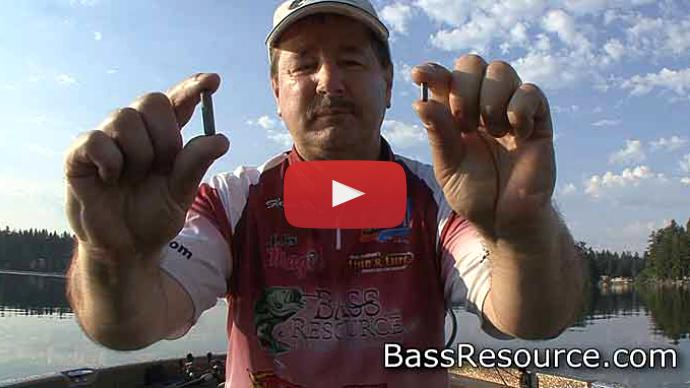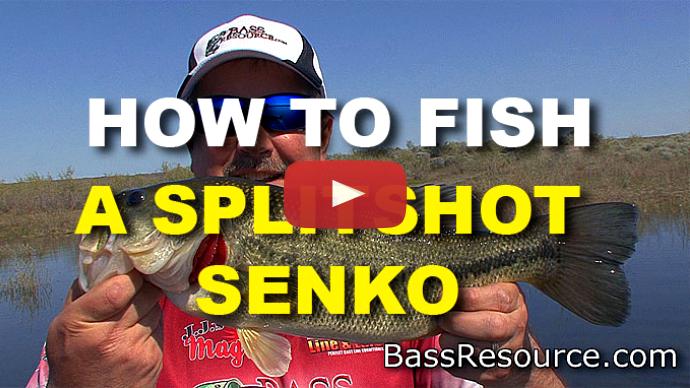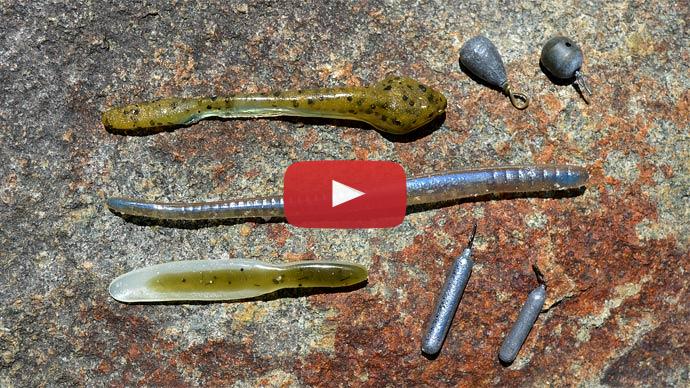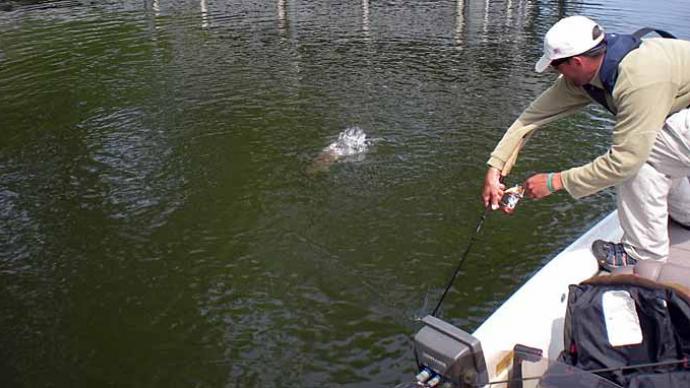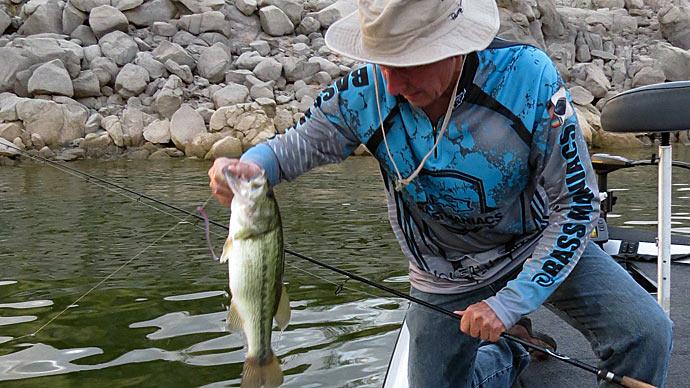Hey, folks, Glenn May here with BassResource.com. Today I want to talk to you about the split shot rig or the mojo rig in some instances. Depending on where you live in the country, some people call it a mojo rig. Really all it is, it's a cylindrical weight with a finesse bait at the end of it, about 18 inches between it. All we're using today . . . I'm going to talk about the rigs, the outfit we're using, and then we're actually go out and fish it. And all we're doing today is we're using a 1/0 light-wire extra wide gap hook. That's important. Nice thin wire hook. This is the finesse approach, we don't want a heavy hook in this case. We want this little bait to be able to flow about and swim about naturally. So we don't want a heavy hook that's going to weight it down. This is just a hand poured worm. I don't even know the brand of this one right now. But, anyway, green pumpkin. About 18 inches up the line. I using an eighth-ounce mojo weight or split shot weight. Eighth-ounce is a great starting point. It's an eighth-ounce to a three-eighth ounce, the weight's in between that. That's going to cover the majority of your fishing with the mojo rig.
Think of this as kind of a baby Carolina rig. It's really all this is, but finesse style. So this bait's going to come up and flip behind the weight, come back down. So you have this weight any closer, you're going to start inhibiting it's ability for it to come up off the bottom, and you're going to kind of kill the action. So a longer leader's what you want. Fishing in clear water, you want the fish to focus on this and not the weight.
I'm using six-pound test. It's a hybrid line. It's fluorocarbon, nylon mix. Now the reason I'm doing that is straight fluorocarbon, when it gets wet, it tends to weight down a little bit and be a little bit heavier than most other lines. And because I want this bait to flow up and flow around freely, I don't want the line to inhibit it. So fluorocarbon line, I feel, inhibits the weight a little bit. Same with braid. You would think braid's a good idea, because braid is actually more buoyant, would help this bait float up of the bottom a little bit. But because we're fishing really clear water, braided line looks like rope in those situations. So we're not going to use braid. This hybrid approach is part fluoro, part mono; works great. You still have the sensitivity that fluorocarbon gives you, but you don't have those buoyancy issues.
Because we're using real light line, six-pound, with this little thin wire hook, we got to match it with the right gear. So we're using a medium light action rod here. It's got plenty of taper and tip at the end of it to absorb the fish. And you're not going to break off the line or you're going to straighten out that hook, say if you're using a medium-heavy action rod or something stouter than that.
Just a spinning outfit to handle that thin line. Bait casting doesn't handle real thin line very well. So spinning is what we're using today. All right. So that's the equipment we're going to use. Now, let's go out and fish it.
All right. So what we have here is a rocky area, a rocky bottom with sparse weeds, which is a great place to fish the split shot rig. Because that cylindrical weight that's going to slide through the rocks a lot easier. It's not going to get hung up as much. Plus, the bait itself is Texas rigged, so it won't get hung up on the weeds or on the rocks as much.
So, when you throw it out there, it's a lob cast. We're not trying to win any distance competitions here. So it's a real light lob. If you've thrown Carolina rigs, you know what I'm talking about. You just bring it back, let the bait settle down for a second, and then just a nice easy cast. This medium light action rod is going to do a lot of the casting for you. So you don't have to really throw it really hard. As a matter fact, if you do, the weight and the bait, they're going to spin in the air and get tangled up before it even hits the water, which is going to ruin your presentation anyway. So don't try to throw it really hard, just a nice lob cast.
Once it hits the water, pay close attention to the line, especially where it enters the water. You want to look and see if it does any jump, pop, twitches, anything like to see if a fish hits it. That's how you see if a fish hits the bait as it falls. So pay particular attention to that.
If it does happen, then just reel up and set the hook. And speaking of setting the hook, this is again, a light line, light wire hook. You don't need to reef on it really hard. Don't do that. Because if you do, you're likely to snap the line, or you may bend the hook and then you'll lose the fish. So instead, you just . . . it's a moderate hook set. You just set it and it's like that. It's just light, easy snap. Some people just reel down and that's it, just reel really hard. Or they do a sweep set where you just bring it to one side and you're set, okay? It's not a very hard hook set at all. Doesn't take much to get that light wire hook to get it in pass the barb. So, take it easy on that hook set.
So what we're going to do, I'm going to show you the first retrieve here. There's several different retrieves, but I'm going to show you the one that made this bait really famous back in the 80s when it first came out, made the split shot as successful as it is. And it still works really well today. So here I'm watching the weight, watching the bait fall, making sure the line doesn't twitch or anything like that till it hits the bottom, which it just did. So now all I'm going to do is I'm going to lift up the weight off the bottom and just slowly reel it in. That's all it is, just nice, slow, steady action. That worm under there with that tail, it just swimming right along. Looks like a little bait fish.
And it works fantastic. You'd be surprised how well this works, especially in clear water. But even in dingy water, this works anywhere. If you're throwing a crank bait, this is a great candidate to throw as well. Especially say, for example, you're throwing crank baits and the bite dies down. Go back through that area and follow back up with this bait. Because you're going to catch a lot more fish that way. You can clean right up. Or if you're fishing with a partner, for example, he's fishing a crank bait up front, you can follow him with this. And you can catch the fish that he missed. Great tactic to use.
All right. So that's tactic number one. The next one I'm going to show you is the one I like to use a lot. And that's just a simple lift and drop retrieve. Now what you're going to do is once it hits the bottom, you're going to lift the rod up slowly. And then as the bait, as you drop it, you're going to drop the rod tip about as fast as the weight and just reel up the slack. So you're letting the weight fall on a slack line, but you're trying to maintain contact with it, just like that. Let it fall back down. And then you lift it back up slowly. And then let it fall straight down while sustaining contact with it.
This is what people refer to as letting something fall on a semi-slack line. Takes a little bit of practice to do. But the reason you want to do that is because you're going to be able to detect bites a lot easier that way, all right? So it's worth learning how to do it. All right.
Then the next retrieve I'm going to show you . . . again, we're going to throw it out there nice and easy. Let it fall on a slack line. Again, I just flip the bail and let it fall on a slack line. If I do see that bite, I'm ready. I got the rod tip down, I'm ready for that strike.
And now all I'm going to do, since it's on the bottom, is I'm simply going to drag it on the bottom. Just move the rod to drag the weight on the bottom. I'm not using the reel. I'm gonna use the reel to bring up slack, and then I drag it on the bottom. And then I just reel up the slack. Another way to do it, you can lift the rod up if you want. But I don't want to lift the bait up off the bottom, so that's why I bring it to the side and then just bring up the slack. Just drag it right along. This is a great way to fish it.
How fast you do it and how long you pause between dragging it is totally up to you. Matter fact, you're going to have experiment each day to figure out what the fish want. Sometimes, they want it moving all the time, and they'll pick it up off the bottom. Other times, they'll only pick it up when it's sitting there. So you have to experiment with it and figure out what it is that's going to trigger that bite.
When you're fishing offshore structure . . . or in the winter time, what I like to do is the same sort of thing, is just take this and throw it off towards the back of the boat. Now, you didn't see that, I know. And, of course, this only works if you're in a boat, not if you're fishing from the bank. But let it fall and then just drag it with the trolling motor. I set the trolling motor on, say, 20, 30, right around there. And I just drag it. I just got my rod tip down. I'm ready for the strike, and I just drag it. I use this almost exclusively during the winter time. Because they want it nice and slow, and they're deep. And you bring it right by their face, and they're going to pick it up.
Speaking of that, here's the different places you want fish it and when you want to fish it. In the summer and in the winter, that's when the majority of the fish are out in the main lake, and they're out in a little bit deeper water. So during those times, I like to fish deeper structure. In main lake points, rock piles, humps, creek channels, creek bends where it comes near the shoreline, ledges, that kind of stuff. That's where I want to fish it. And then in the spring and the fall, the fish, they're much more shallow during that time of the year. That's when I want to go in the back of the coves, back of creek channels. I want to fish protected bays and coves. Grassy flats are my favorite. Love doing that, especially when it gets near a creek channel, near a drop. Those are the areas you want to target. If you target those areas with the techniques I just showed you, you're going to catch a lot of fish.
Have fun with it. For more tips like this, visit BassResource.com.

